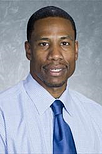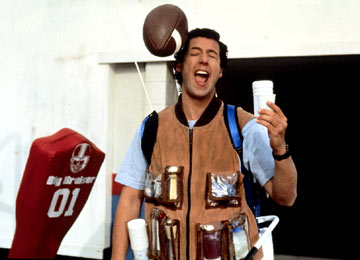Check out Brian McCormick’s interview with Ray Eady, Strength and Conditioning Coach from University of Wisconsin. His interview can also be found on Brian’s Newsletter, “Hard2Guard Player Development Newsletter” a must read for all those that follow the game of basketball. Ray talks about training and evaluating the basketball athlete along with special considerations for the female athlete.
This week, I have an interview with Ray Eady, the strength and conditioning coach for the women’s basketball program at the University of Wisconsin. Previously, he was the head strength and conditioning coach for men’s and women’s basketball at the University of Akron and Northeastern University. Eady holds a Masters degree in Exercise Physiology form the University of Akron and is a Certified Strength and Conditioning Specialist (NSCA – CSCS) and a Performance Enhancement Specialist (NASM – PES).
BM: What assessments or evaluations do you use with your players in the pre-season?
Eady: During the pre-season, the athletic trainer and I will assess and evaluate the players in a couple of areas. First, we will do a functional movement screen. I like doing the movement screens because it allows me to asses an array of total body movement mechanics. As you know, proper movement mechanics is needed to perform efficiently, effectively, and injury free on the basketball court. The screens we typically use are:
1. Overhead squat test
2. Hurdle test
3. Active hamstring test
4. In-line lunge test
In addition to the screens, we will do the hop and stop test and the leap and stop test to assess a player’s ability to produce, absorb, and stop force on one leg.
We will also do some performance evaluations to measure leg power and strength. To measure power, we will do a series of vertical jump test.
1. Static jump test to measure starting strength
2. Countermovement jump test to measure speed-strength
3. 4-jump test to measure how efficient a player is using their power repeatedly
We perform these jumps on a just-jump mat while the athletes are holding a dowel on the back of their shoulders (as if they were going to do a back squat). The goal is to eliminate the action of the arms to really determine leg power. I like performing these tests because they can help you determine if certain players need more strength work or more speed/elastic work.
For conditioning, we will do the standard 300 yard shuttle test which is a great test to measure anaerobic capacity. This year, I will test the players in the 150 yard shuttle because the energy system demands are bit different (anaerobic power).
Lastly, we will do body composition assessments to determine body fat and lean muscle tissue. I want our players to be at an optimal body weight for increased performance and to reduce the chances of injury.
I must say the most overrated test when evaluating basketball players has to be the bench press test. So many coaches put a premium on the results. I am not saying basketball players don’t need upper body pushing strength but the relevance it has on basketball performance is minimal. When the bench press can prevent a female player from tearing her ACL then I will put more emphasis on the test.
Let’s make it clear, performance evaluations will never truly tell you if a player will have some success on the court. It merely predicts future performance. All the strength and power in the world won't make you a successful athlete unless you're able to apply it in sport-specific contexts and integrate it with finer motor qualities.
I don’t try to re-invent the wheel when it comes to testing. I want to make my evaluations meaningful for my athletes and to make it applicable for what they will most likely be doing on the court.
BM: Do you have any good/different drills that you use with women’s players to teach proper landing and cutting techniques to prevent ACL injuries?
Eady: First, I don’t think we can ever prevent ACL injuries in female basketball players. We all know that female players are two to eight times more likely to sustain an ACL tear when compared to males. Anatomical and physiological characteristic such as pelvis width (Q-angle), femoral notch, poor glute and hamstring recruitment, and joint and ligament laxity during the menstrual cycle puts the female player at risk. However, we can reduce the rate of occurrences by having female players participate in a well designed and progressive strength training program that focuses on improving maximal strength development. The stronger females can become, the less likely they will get injured.
Second, strength is the foundation for improving movement efficiency, central nervous system efficiency, nervous system efficiency, neuromuscular control, balance, coordination, stability, deceleration, and reaction. All of these attributes are needed to reduce the rate of ACL injuries. With these non-contact injuries, poor lower body eccentric strength is usually at the root of the problem.
Also, many jump programs tend to emphasize landing with correct technique but don’t address the ability to get into a safe landing position. If a player lacks the ankle, hip and T-spine mobility (and once again, strength) to get into a safe landing position with just her body weight, how are they ever going to do it when the forces are higher? If you are going to address landing and cutting mechanics it is important that mobility and strength (most specifically isometric and eccentric strength) are addressed concurrently. The ability to decelerate, absorb and stop the forces a player creates on the court is the key.
With that being said, I am a fan of doing some yielding isometric (activation) work prior to our jump/landing drills. Yielding isometrics is great for re-enforcing how to control, absorb, and stop force production (which occurs when landing from a jump or changing directions). Studies have shown that a person can recruit 5% more motor-units/muscle fibers during a maximal isometric muscle action than during a maximal eccentric or maximal concentric action. This is great since we need our muscles to activate and fire eccentrically to decelerate force. Of course, isometric work is not dynamic in nature but it’s also great for teaching, assessing and correcting body positioning. After our isometric work we will follow up with some dynamic work.
For example, if we are doing double-leg jumps, we will do some partner resisted isometric squat holds to activate the musculature of the hips. We will hold at three positions:
1. Statically a few inches from the starting position
2. Statically at mid range
3. Statically at full contraction
Each position is held for approximately 10 seconds. Following the isometric holds, we will perform maximum effort squat jumps with sticks (sticking the landing and holding for 5 seconds without any movement). We do this set-up for the majority of our jump training/landing drills.
Once again, the isometric work prior to our jumps just prepares our neuromuscular system for the dynamic action that is about to take place. It should be noted that the dynamic movement must mimic the isometric movement (i.e. squat holds for box jump downs, split squat holds for split squat jumps, single leg holds for single leg jumps, hops, leaps, etc.)
BM: Since girls/women tend to have poor hamstring strength compared to quad strength, what type of exercises (emphasis) do you do to correct imbalance or strengthen the weakness?
Eady: Of course, with most female basketball players, you will notice some lumbo-pelvis-hip postural distortion. This includes shortened and tight quads and hip flexors and lengthened and weak hamstrings and glutes. Therefore, our workouts always include some remedial and prehab work to correct these lower body imbalances. This will include soft tissue work, hip flexibility, glute activation, core stability and hip mobility.
Some coaches are opposed to isolation work for specific musculatures but I think they have their role in training, especially when doing remedial work. With that being said, we will do a variety of isolation work for the posterior hip (glute max), lateral hip (glue medius), and the anterior hip (psoas).
Within our strength training session, we will include more ground base posterior chain/hip extension exercises to re-enforce our remedial work. On the days we squat, we will include more unilateral post-chain work. On the days we do single leg work (i.e. split squats, lunge variations), we will do more bilateral post-chain work. My favorite exercise for posterior chain development and strength is actually the box squat. There has been some debate about the squat especially for athletes that participate in movement based team sports. However, I believe it’s a great exercise to strengthen the glutes and hamstrings and improve overall strength. Of course, I would only prescribe this exercise if a player is capable and able to perform it proficiently. Another favorite exercise is the one-leg squat to a bench or box. This is a great exercise to improve unilateral eccentric leg strength.
BM: Now that the season is over, how do you structure or periodize the players’ off-season? Do you use different training blocks emphasizing different things?
Eady: My goal for the off-season is to prepare our team for the upcoming competitive season by developing the physical qualities need to perform at a healthy and optimal level. Of course, this includes improving strength, power, sport-specific speed, quickness and conditioning. At the end of every competitive season, I will develop a yearly training plan based on a couple of factors (a few many include):
1. The number of returning players. Will we be a veteran or a rebuilding team?
2. What type of playing style will we execute offensively and defensively?
3. Are we a team that needs toughness? More team unity?
4. Are we skilled at all five positions? How many players do we have at each position?
5. How will certain players be utilized offensively and defensively?
6. Do some players need additional work (i.e. weight loss, weight gain, speed, etc.)?
Once these factors are identified, I can develop and implement a plan to meet our competitive needs.
I divide the training year into blocks (off-season I, off-season II, pre-season I, pre-season II, and in-season). Each block focusing on a specific physical quality. For example, off-season I is typically dedicated to teaching and re-educating the players on how to perform certain “technical” lifts, as well as improving posture, balance, coordination, movement, core stability, and GPP (work capacity). These are the physical qualities that are needed to successfully complete summer workouts.
Our main goal for off-season II is to improve sub-maximal and maximal strength which is extremely important. Strength is one of the catalysts for enhancing athleticism.
We still train other qualities such as strength-speed, speed-strength, general conditioning, etc. but our number one priority is to get strong. This particular block is the best time to achieve this quality because of a couple of reasons:
1. On-court activity is usually reduced during the summer. Players can give more energy and mind share to weight room activities.
2. I don’t believe you can continue to improve strength at an optimal rate during the pre- or competitive seasons because players are now being exposed to stressors that can negatively impact strength gains. (i.e. individual workouts with coaches, team practices, conditioning sessions, pick-up games, late night study sessions, early classes, etc.)
During pre-season I our goal is to prepare for the start of official practice. The physical qualities that are highly emphasized are basketball specific movement/endurance, power, and strength. Our training tends to be more specialized to the demands of the sport.
The goal for pre-season II is to prepare for the beginning portion of our non-conference game schedule. At this point in time, on-court activity has increased dramatically. Weight training frequency and volume will decrease but when we train the focus is to maintain strength gains achieved during the off-season and pre-season I. We tend to do more therapeutic work during these sessions to facilitate the recovery process as well.
Finally, the goal for the in-season is to keep the players healthy and competitive. Like most strength coaches, I understand the importance of in-season strength training but I also understand that practice takes priority. You can’t put too much physical and mental stress on your players that they are unable to perform efficiently on the court. Eventually, you will have overtrained players and not so happy coaches.
__________________________________________________
Last chance to register at a discount for the conference!!








